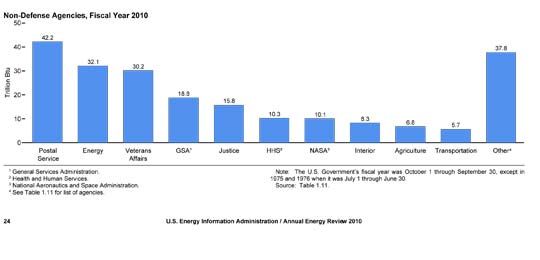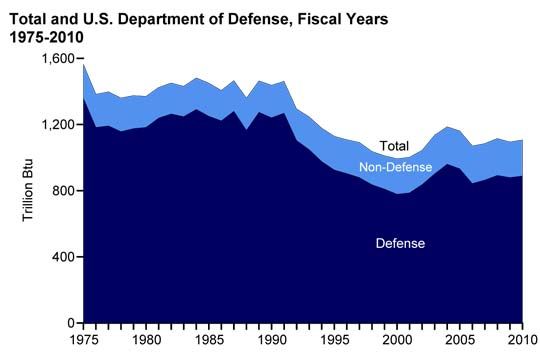If you were to ask the Postmaster General about his most pressing problems, Patrick Donahoe probably wouldn’t put meeting sustainability goals at the top of the list.
The U.S. Postal Service is in dire straights, unable to keep up with onerous requirements to pre-fund retiree health benefits. Neither snow nor rain nor heat nor gloom of night stays these couriers from the swift completion of their appointed rounds -- but budget shortfalls could be a death sentence.
Although the post office’s problems did not arise from its energy use, the 2010 Annual Energy Review from the U.S. Energy Information Administration shows that the Postal Service trails only the U.S. Department of Defense in its energy consumption, using 42.2 trillion Btu in 2010. That does not mean that mail service is anywhere near the DOD's rate of usage, though -- the agency that oversees military operations consumed nearly 900 trillion Btu in the same year.

The Postal Service is working toward its sustainability goal of reducing facility energy use by 30 percent and vehicle petroleum use by 20 percent by 2015. However, the USPS' current energy use is similar to what it was a decade ago, before everyone started paying bills online and sending e-cards.
The mail trucks still roll every day except Sunday (for now), although the volume of mail has dropped 20 percent in the past five years. To reach its sustainability goals, the Postal Service is relying on “Lean Green teams” at each facility to help reduce operational costs and carbon footprints. However, only about a quarter of the service's facilities even have Lean Green teams in place so far. In 2010, the USPS saved $5 million in reduced water and fuel use, but that’s a drop in the bucket across 33,000 facilities racking up $1.7 billion in annual fuel costs.
Most of the success has been in facilities management, where the Postal Service has reduced its energy use by nearly 30 percent since 2003. However, according to the service’s most recent sustainability report, it is way off target in meeting its goal of reducing petroleum fuel use by 2015. Currently, it is using 3.5 percent more fuel than in 2005 because it has a million new addresses to serve every year, according to the sustainability report. In comparison, FedEx has improved its total fleet miles per gallon by 16.1 percent in the U.S. in the past five years.
Although the post office might not stack up to FedEx’s fuel efforts, many government agencies have not seen significant declines in energy use in the last decade. The recession saw a dip across nearly all agencies, but only the Department of Transportation saw a significant drop in energy usage, from 18 trillion Btu down to 5.6 trillion Btu, a reduction which first occurred between 2002 and 2003 and which the DOT has been able to sustain since then.
The DOD is still the 800-pound gorilla in the room in terms of government energy use, but it has various efforts underway to reduce its dependence on foreign oil and increase energy efficiency -- which is as much a matter of troop safety as it is about controlling the bottom line. The DOD is planning on cutting non-tactical land fleet fossil fuel use by 30 percent by 2020. Currently, the DOD spends $11 billion annually on liquid petroleum fuel.

The Postal Service is making some strides, but it can’t find a way to keep up with mail delivery and cut fuel use at the same time. More than 6,000 gas-powered vehicles were replaced with more fuel-efficient ones and alternative fuel vehicles increased by 9 percent from 2009 to 2010. The service is testing hybrid electric vans and conversion technologies, but those are still in pilot stages. Its most significant proposal for cutting fuel use is to end Saturday delivery.
For the Postal Service, efficiency is sorely needed at every level, and clearly some of its efforts are paying off more than others. Starting in 2010, the post office became the first federal agency that will include energy and fuel reduction metrics in merit pay raises.
While pay-for-performance should yield some improvements, there are many factors that are handcuffing the Postmaster General from meeting sustainability goals. Closing post offices is a political and community issue that is bringing a lot of anger to the surface (although in some cases, there is another post office just a mile or two away). Even the prospect of ending Saturday mail service has emerged as a a hot-button issue.
Working aggressively to meet sustainably goals will be one way the Postal Service can maintain current delivery standards while it waits on congressional action. In the meantime, maybe the Postmaster General should call up the Secretary of Defense to get some ideas.



